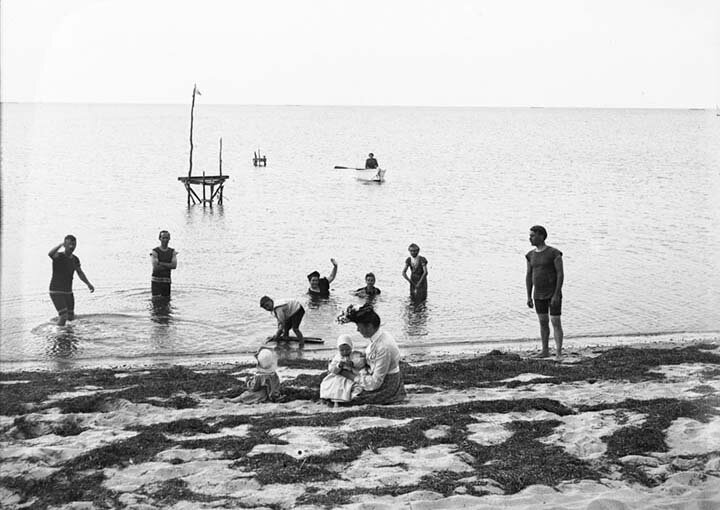My favorite exhibit at The Cobb House is the case containing artifacts from Helen Keller. It is just amazing to me that she visited Brewster! I admire her letter and her beautiful prose about Brewster. She was a truly extraordinary person. ~ BHS Docent, 1799 Cobb House Museum
The orphaned Anne Sullivan first met Brewster resident Sophie Hopkins at the Perkins School. Nearly blind herself, Sullivan had been sent to the school at state expense. Mrs. Hopkins brought young Anne with her when she returned to Cape Cod during the summer recess. An abiding friendship formed, and Sullivan revisited Brewster each year. In 1887, Mrs. Keller wrote to the Perkins School for help, on the recommendation of Alexander Graham Bell. The school sent her Anne Sullivan as teacher for her child. In the spring of 1888, Mrs. Keller and Anne Sullivan brought Helen to the Perkins School, and that summer Sullivan brought the child with her to Cape Cod. They returned numerous times, staying at 1491 Main Street and 393 Lower Road. In her earliest autobiography, My Story, written when Keller was twelve, she describes this Cape visit:
Helen Keller and Doll with Anne Sullivan
by Cornelius Chenery – July 1888, Brewster
“I now wish to speak of my visit to the seaside; for it was during my sojourn at the north that I received my first impression of the great ocean. It was about the middle of July, after my mother had returned to our home in the Sunny South, that Teacher and I went to Brewster, a pleasant little town of Cape Cod, where we spent a very happy summer.
The morning after our arrival, I awoke bright and early. A beautiful summer day had dawned, the day on which I was to make the acquaintance of a somber and mysterious friend. I got up, and dressed quickly, and ran down stairs. I met Teacher in the hall, and begged to be taken to the sea at once. “Not yet, she responded, laughing. “ We must have breakfast first.”
As soon as breakfast was over, we hurried off to the shore. Our pathway led through low sandy hills, and, as we hastened on, I often caught my feet in the long, coarse grass, and tumbled, laughing, in the warm, shining sand. The beautiful warm air was peculiarly fragrant, and I noticed it got cooler and fresher as we went on.
Suddenly we stopped, and I knew, without being told, the sea was at my feet. I knew, too, it was immense! Awful! And for a moment some of the sunshine seemed to have gone out of the day. But I do not think I was afraid; for later, when I had put on my bathing suit, and the little waves ran up on the beach and kissed my feet, I shouted for joy, and plunged fearlessly into the surf. But, unfortunately, I struck my foot on a rock, and fell forward into the cold water.
Then a strange, fearful sense of danger terrified me. The salt water filled my eyes and took away my breath, and a great wave threw me up on the beach as easily as if I had been a little pebble. For several days after that, I was very timid, and could hardly be persuaded to go in the water at all; but by degrees, my courage returned, and almost before the summer was over, I thought it the greatest fun to be tossed about by the sea-waves.
Oh, the happy, happy hours I spent, hunting the wonderful shells! How pretty they were with their lovely, fresh hues and exquisite shapes! And how pleasant it was to sit on the sandy bank and braid the sea grass, while Teacher told me story of the sea, and described, in simple words that I could understand, the majestic ocean, and the ships that drifted in the distance like white-winged birds.”
Helen Keller later wrote:
“I could never stay long enough on the shore. The tang of the untainted, fresh and free sea air was like a cool, quieting thought, and the shells and pebbles and the
seaweed with tiny living creatures attached to it never lost their fascination for me. One day, Miss Sullivan attracted my attention to a strange object which she had captured basking in the chilly water. It was a great horseshoe crab–the first one I had ever seen. I felt of him and thought it strange that he should carry his house on his back.”
The Brewster Historical Society is deeply grateful to Alys and Raymon Walker, relatives of photographer Cornelius Chenery, for the donation of this historic photograph and letter by Helen Keller.




